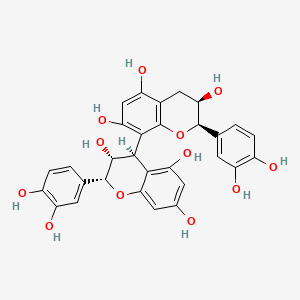| MeSH term | MeSH ID | Detail |
|---|---|---|
| Body Weight | D001835 | 333 associated lipids |
| Diabetes Mellitus | D003920 | 90 associated lipids |
| Diabetic Nephropathies | D003928 | 39 associated lipids |
| Prostatic Neoplasms | D011471 | 126 associated lipids |
Procyanidin B2
Procyanidin B2 is a lipid of Polyketides (PK) class. The involved functions are known as conjugation, Methylation, Excretory function, enzyme activity and sulfatase activity. Procyanidin b2 often locates in Blood, Epidermis and Upper Gastrointestinal Tract. The associated genes with Procyanidin B2 are NR5A2 gene, HRAS wt Allele, CFB gene, PTGS2 gene and MAPK8 gene.
Cross Reference
Introduction
To understand associated biological information of Procyanidin B2, we collected biological information of abnormalities, associated pathways, cellular/molecular locations, biological functions, related genes/proteins, lipids and common seen animal/experimental models with organized paragraphs from literatures.
What diseases are associated with Procyanidin B2?
There are no associated biomedical information in the current reference collection.
Possible diseases from mapped MeSH terms on references
We collected disease MeSH terms mapped to the references associated with Procyanidin B2
PubChem Associated disorders and diseases
What pathways are associated with Procyanidin B2
There are no associated biomedical information in the current reference collection.
PubChem Biomolecular Interactions and Pathways
Link to PubChem Biomolecular Interactions and PathwaysWhat cellular locations are associated with Procyanidin B2?
Visualization in cellular structure
Associated locations are in red color. Not associated locations are in black.
Related references are published most in these journals:
| Location | Cross reference | Weighted score | Related literatures |
|---|
What functions are associated with Procyanidin B2?
Related references are published most in these journals:
| Function | Cross reference | Weighted score | Related literatures |
|---|
What lipids are associated with Procyanidin B2?
There are no associated biomedical information in the current reference collection.
What genes are associated with Procyanidin B2?
Related references are published most in these journals:
| Gene | Cross reference | Weighted score | Related literatures |
|---|
What common seen animal models are associated with Procyanidin B2?
There are no associated biomedical information in the current reference collection.
NCBI Entrez Crosslinks
All references with Procyanidin B2
Download all related citations| Authors | Title | Published | Journal | PubMed Link |
|---|---|---|---|---|
| Foo LY et al. | A-Type proanthocyanidin trimers from cranberry that inhibit adherence of uropathogenic P-fimbriated Escherichia coli. | 2000 | J. Nat. Prod. | pmid:11000024 |
| Natsume M et al. | Analyses of polyphenols in cacao liquor, cocoa, and chocolate by normal-phase and reversed-phase HPLC. | 2000 | Biosci. Biotechnol. Biochem. | pmid:11210120 |
| Waffo-Téguo P et al. | Potential cancer-chemopreventive activities of wine stilbenoids and flavans extracted from grape (Vitis vinifera) cell cultures. | 2001 | Nutr Cancer | pmid:11962253 |
| Butterweck V et al. | Pharmacological and endocrine effects of Hypericum perforatum and hypericin after repeated treatment. | 2001 | Pharmacopsychiatry | pmid:11518068 |
| Lin LC et al. | Immunomodulatory proanthocyanidins from Ecdysanthera utilis. | 2002 | J. Nat. Prod. | pmid:11975489 |
| Malien-Aubert C et al. | Influence of procyanidins on the color stability of oenin solutions. | 2002 | J. Agric. Food Chem. | pmid:12010001 |
| Stevens JF et al. | Identification and in vitro biological activities of hop proanthocyanidins: inhibition of nNOS activity and scavenging of reactive nitrogen species. | 2002 | J. Agric. Food Chem. | pmid:12033808 |
| Abrahams S et al. | Identification and biochemical characterization of mutants in the proanthocyanidin pathway in Arabidopsis. | 2002 | Plant Physiol. | pmid:12376625 |
| Wittig J et al. | Quantification of procyanidins in oral herbal medicinal products containing extracts of Crataegus species. | 2002 | Arzneimittelforschung | pmid:11878204 |
| Osakabe N et al. | Catechins and their oligomers linked by C4 --> C8 bonds are major cacao polyphenols and protect low-density lipoprotein from oxidation in vitro. | 2002 | Exp. Biol. Med. (Maywood) | pmid:11788784 |
